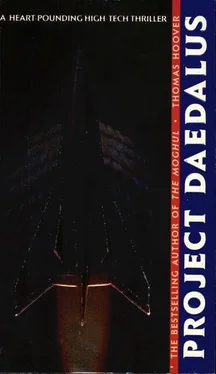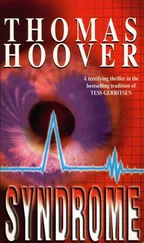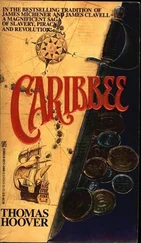Thomas Hoover - Project Daedalus
Здесь есть возможность читать онлайн «Thomas Hoover - Project Daedalus» весь текст электронной книги совершенно бесплатно (целиком полную версию без сокращений). В некоторых случаях можно слушать аудио, скачать через торрент в формате fb2 и присутствует краткое содержание. Жанр: Триллер, на английском языке. Описание произведения, (предисловие) а так же отзывы посетителей доступны на портале библиотеки ЛибКат.
- Название:Project Daedalus
- Автор:
- Жанр:
- Год:неизвестен
- ISBN:нет данных
- Рейтинг книги:5 / 5. Голосов: 1
-
Избранное:Добавить в избранное
- Отзывы:
-
Ваша оценка:
- 100
- 1
- 2
- 3
- 4
- 5
Project Daedalus: краткое содержание, описание и аннотация
Предлагаем к чтению аннотацию, описание, краткое содержание или предисловие (зависит от того, что написал сам автор книги «Project Daedalus»). Если вы не нашли необходимую информацию о книге — напишите в комментариях, мы постараемся отыскать её.
Project Daedalus — читать онлайн бесплатно полную книгу (весь текст) целиком
Ниже представлен текст книги, разбитый по страницам. Система сохранения места последней прочитанной страницы, позволяет с удобством читать онлайн бесплатно книгу «Project Daedalus», без необходимости каждый раз заново искать на чём Вы остановились. Поставьте закладку, и сможете в любой момент перейти на страницу, на которой закончили чтение.
Интервал:
Закладка:
The passports were Bulgarian, a forgery, stamped with a Greek entry visa one week old. Port of entry: Athens. But they had to be KGB. No wonder Novosty was in trouble now. He was playing both sides of the game.
Finally he pulled around the head of the other man, the one swathed in black, the one who had almost killed him twice. This was the one he'd been saving till last, trying to guess.
A bloody, brutal face stared back at him, and through the torn shirt he could see a garish tattoo covering the back and chest. At first he couldn't believe it, so he lit a match and cupped it against the rain while he ripped open the rest of the cloth to be sure. History swirled around him.
Irezumi. The rose-colored dragon-and-phoenix tattoo was regulation issue-insignia of a kobun of the right-wing ultranationalist Mino-gumi, the foremost Yakuza crime syndicate of Japan. He knew it well.
CHAPTER FIVE
Thursday 7:30 A.M.
Andrei Petrovich Androv, director of propulsion systems, gazed out across the windy strait, feeling the chill of the sea air cut through his fur-lined trench coat.
Physically, he was almost mythic, a giant from Grimms' fairy tales. He had a heavy face nature should wish on no man, tousled gray hair, bushy eyebrows eternally cocked in skepticism, and a powerful taste for Beethoven's string quartets, which he played incessantly in the instrument room. He bore, in fact, more than a passing resemblance to that aging, half-mad genius. Now seventy-one, he, too, possessed a monumental mind and was acknowledged worldwide as the founding intellect behind the Soviet space program.
Yes, he was thinking, this location had been ideal. Here in remote Hokkaido they had constructed a high-security facility surrounded by wind-swept wilderness-virgin forests and snow-covered volcanoes. Even for him, a man long used to the harsh winters of Baikonur, the almost Siberian weather along this coast was intimidating. This was the most isolated, austere, and yes, lonely spot he'd ever known.
But it was the perfect site. Mino Industries had insisted, rightly, on this northernmost point of Japan for the facility, here in a national park on Cape Soya, fifty kilometers west of Wakkanai. The facility itself had been constructed entirely underground, excavated beneath this rocky northern coast in order to be secure and invisible to satellite reconnaisance, both Soviet and American. Such excessive precautions, hardly a problem in the New Mexico desert when the first atomic bomb was tested, were the order of the day in this new era of space photography. Nowadays you even had to find ways to mask telltale waste heat expulsion, which always betrayed an unmistakable infrared signature.
In that respect, too, their choice of this spot was strategic, with the freezing currents of the La Perouse Strait between northern Hokkaido and Sakhalin providing a continuous and thermally stable 12 degrees Celsius feed for the heat exchangers. Only the ten-thousand-meter test runway could not be concealed full-time, but it had been carefully camouflaged and was used only at night.
A massive breaker crashed against the rocks at the north end of the shore, sending ice-flecked spray upward into the morning mist. As he watched the freezing cloud and felt its ice collecting on his cheeks, he glanced at his watch. It was seven-forty. He took one last survey of the choppy gray sea and turned back. His daily morning walk down to the shore had achieved its purpose: His mind was as sharp as the icy wind whistling through the rocks. He needed to be at Number One by 0800 hours, when the final test run was scheduled to begin.
As he did every morning, he retraced the concrete steps that led down to the stainless steel entry door leading into the West Quadrant. When he reached it, he inserted a coded plastic card into the slot, pronounced his name into the black microphone flush with the metal doorframe, and signaled the TV eye. Two seconds later a simulated voice from the computer granted him access, the door sliding aside.
He nodded to the guards, then moved on down the long neon-lit, gray hallway. When he reached the unmarked door of Number One, he paused to listen. The whine of the fans was still a high growl as the engineers ran through the warm-up preparatory to bringing its six 25,000-horse- power motors to full power. Contenting himself that vibration in the fan housings remained at acceptable levels, he flashed his ID to the guard, inserted his magnetic card, and shoved open the door.
Without a word, he marched to his desk by the main video panel and slipped a scratched old Melodiya disk onto his ancient turntable. Moments later, the first movement of Beethoven's Quartet in A Minor boomed from the speakers.
"We are ready to switch on the laser field, Doktor Androv." A young Soviet technician approached gingerly. "If you wish, we can direct the holograms here to the master terminal."
"More of your pretty pictures?" He was examining the data on the video screens. Then he nodded. "Da. Ya gotov. When you will."
As he stared at the screens, he again found himself growing pensive. The project was all but finished now. His lifelong dream.
He silently counted their breakthroughs. The new material being used for the leading edges and scramjet struts, a proprietary titanium alloy coated with a ceramic skin, had turned out to be much lighter than aluminum and eight times as strong. Full-scale sections of the leading edges of the wings and the engine struts had been subjected to ten- minute blasts of 3,500 degrees Fahrenheit air at Mach 7 in the high-temperature tunnel with no deformation or structural failure.
Then the turboramjet-scramjets, four meters in diameter and nine meters long, had all been given full-scale static tests at the aeropropulsion facility in the south, where they were operated to Mach 8 at temperatures ranging from minus 100 to over 1900 degrees Fahrenheit. Massive refrigeration units and gas heaters had been used to achieve the temperature range, while liquefied air was pumped into the intakes to duplicate a complete hypersonic duty cycle.
Maybe, he thought, they were ready for a full-scale test flight. Only one problem remained: a hint of supersonic wave drag the low-temperature helium wind tunnel had shown could develop behind the leading edges. He had ordered the project director to run a computer simulation examining the performance of two new ceramic spoilers, modified canard foreplanes, and the preliminary results indicated the drag would be effectively damped. Still, he was determined to test that design modification with a full run-up here in Number One, the massive hypersonic tunnel that contained a ten-meter scale model of the vehicle.
As he sat thinking, he neglected to acknowledge the arrival of the project director, now advancing down the concrete steps that led from the steel entry door.
"Dobriy utro, Doktor Androv." Taro Ikeda's good-morning greeting was heavily accented. "Kak pashaviatye?"
"Khoroshau." Andrei Petrovich Androv nodded absently, still engaged in his thoughts. "Dobriy utro."
"Today I have more good news," Ikeda continued as he headed for the coffee urn. "My 0730 briefing included a report that during the night our Tsukuba team completed a simulation of the aerodynamic performance of your suggested modification all the way to Mach 25. Just as you envisioned, leading-edge deformation and vortex bursts were reduced to values well within the acceptable envelope." He looked back. "Which makes me question whether we really need to proceed with this morning's run."
"Your SX-10 only tells us how a fuselage performs if airflows are ideal," Androv replied. "At hypersonic temperatures and velocities air doesn't behave predictably, like a perfect gas. Fluid dynamics models can only give us approximations of actual characteristics." He glanced up from the video control panel, his face determined. "It is my son, Yuri, who will be in the cockpit of these vehicles, and my experience is you never put your faith in simulations. In the hypersonic regime, computer simulations are just guesswork, a shortcut not worth a drozhky driver's fart."
Читать дальшеИнтервал:
Закладка:
Похожие книги на «Project Daedalus»
Представляем Вашему вниманию похожие книги на «Project Daedalus» списком для выбора. Мы отобрали схожую по названию и смыслу литературу в надежде предоставить читателям больше вариантов отыскать новые, интересные, ещё непрочитанные произведения.
Обсуждение, отзывы о книге «Project Daedalus» и просто собственные мнения читателей. Оставьте ваши комментарии, напишите, что Вы думаете о произведении, его смысле или главных героях. Укажите что конкретно понравилось, а что нет, и почему Вы так считаете.












